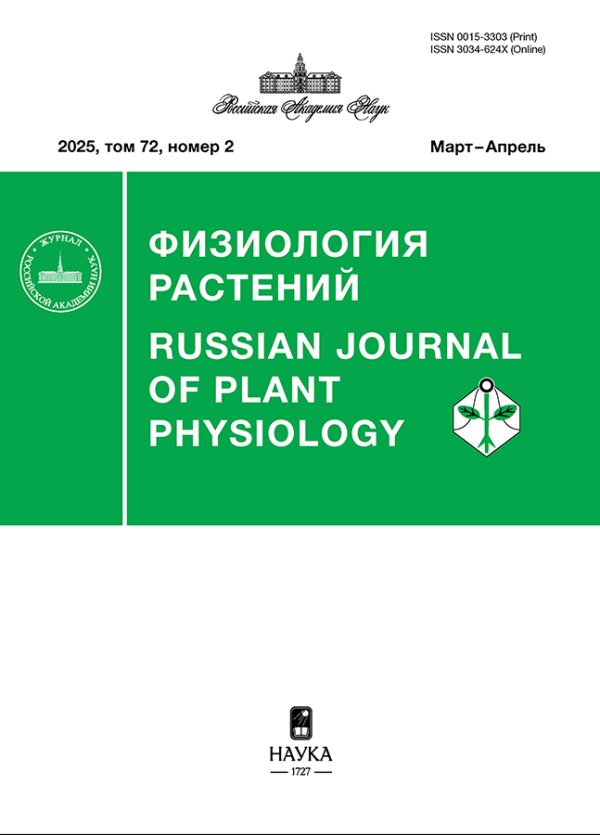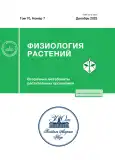Accumulation of Polyphenols and Naphthoquinones in Morphogenic Cultures of Two Drosera Species
- Authors: Morshneva A.V.1,2, Khandy M.T.1,2, Grigorchuk V.P.1, Chernoded G.K.1, Gorpenchenko T.Y.1
-
Affiliations:
- Federal Scientific Center of the East Asia Terrestrial Biodiversity, Far Eastern Branch, Russian Academy of Sciences
- Far Eastern Federal University
- Issue: Vol 70, No 7 (2023)
- Pages: 858-865
- Section: ЭКСПЕРИМЕНТАЛЬНЫЕ СТАТЬИ
- URL: https://journals.rcsi.science/0015-3303/article/view/233795
- DOI: https://doi.org/10.31857/S0015330323600717
- EDN: https://elibrary.ru/ZFGIDI
- ID: 233795
Cite item
Full Text
Abstract
A rhizogenic culture of Drosera capensis L. was obtained. An HPLC method with UV and mass-spectrometric detection was applied to analyze the effect of different drying protocols on the yield of individual polyphenols and 1,4-naphthoquinones from the rhizogenic culture of D. capensis L. The results of this analysis were compared with similar data obtained on the previously established morphogenic culture of D. rotundifolia L. that has been maintained for more than 15 years. In the rhizogenic culture of D. capensis L., six compounds were identified for the first time (myricetin-3-O-β-glucopyranoside, rossoliside, 3,3'-di-O-methylellagic acid 4-O-β-D-glycopyranoside, myricetin, 3,3'-di-O-methylellagic acid, and plumbagin).
About the authors
A. V. Morshneva
Federal Scientific Center of the East Asia Terrestrial Biodiversity, Far Eastern Branch, Russian Academy of Sciences; Far Eastern Federal University
Email: morshneva.av@students.dvfu.ru
Vladivostok, Russia; Vladivostok, Russia
M. T. Khandy
Federal Scientific Center of the East Asia Terrestrial Biodiversity, Far Eastern Branch, Russian Academy of Sciences; Far Eastern Federal University
Email: morshneva.av@students.dvfu.ru
Vladivostok, Russia; Vladivostok, Russia
V. P. Grigorchuk
Federal Scientific Center of the East Asia Terrestrial Biodiversity, Far Eastern Branch, Russian Academy of Sciences
Email: morshneva.av@students.dvfu.ru
Vladivostok, Russia
G. K. Chernoded
Federal Scientific Center of the East Asia Terrestrial Biodiversity, Far Eastern Branch, Russian Academy of Sciences
Email: morshneva.av@students.dvfu.ru
Vladivostok, Russia
T. Yu. Gorpenchenko
Federal Scientific Center of the East Asia Terrestrial Biodiversity, Far Eastern Branch, Russian Academy of Sciences
Author for correspondence.
Email: morshneva.av@students.dvfu.ru
Vladivostok, Russia
References
- Didry N., Dubreuil L., Trotin F., Pinkas M. Antimicrobial activity of aerial parts of Drosera peltata Smith on oral bacteria // J. Ethnopharm. 1998. V. 60. P. 91. https://doi.org/10.1016/S0378-8741(97)00129-3
- Crowder A.A., Pearson M.C., Grubb P.J., Langlois P.H. Drosera L. // J. Ecol. 1990. V. 78. P. 233. https://doi.org/10.2307/2261048
- Egan P.A., Kooy F. Phytochemistry of the carnivorous sundew genus Drosera (Droseraceae) – future perspectives and ethnopharmacological relevance // Chem. Biodiversity. 2013. V. 10. P. 1774. https://doi.org/10.1002/cbdv.201200359
- Kämäräinen T., Uusitalo J., Jalonen J., Laine K., Hohtola A. Regional and habitat differences in 7-methyljuglone content of Finnish Drosera rotundifolia // Phytochem. 2003. V. 63. P. 309. https://doi.org/10.1016/S0031-9422(03)00115-8
- Marczak L., Kawiak A., Lojkowska E., Stobieck M. Secondary metabolites in in vitro cultured plants of the genus Drosera // Phytochem. Anal. 2005. V. 16. P. 143. https://doi.org/10.1002/pca.833
- Budzianowski J., Skrzypczak L., Kukulczanka K. Phenolic compounds of Drosera intermedia and D. spathulata from in vitro cultures // Acta Hortic. 1993. V. 330. P. 277. https://doi.org/10.17660/ActaHortic.1993.330.36
- Gu J.Q., Graf T.N., Lee D., Chai H.B., Mi Q., Kardono L.B.S., Setyowati F.M., Ismail R., Riswan S., Farnsworth N.R., Cordell G.A., Pezzuto J.M., Swanson S.M., Kroll D.J., Falkinham J.O., et al. Cytotoxic and antimicrobial constituents of the bark of Diospyros maritima collected in two geographical locations in Indonesia // J. Nat. Prod. 2004. V. 67. P. 1156. https://doi.org/10.1021/np040027m
- Zehl M., Braunberger C., Conrad J., Crnogorac M., Krasteva S., Vogler B., Beifuss U., Krenn L. Identification and quantification of flavonoids and ellagic acid derivatives in therapeutically important Drosera species by LC-DAD, LC-NMR, NMR, and LC-MS // Anal. Bioanal. Chem. 2011. V. 400. P. 2565. https://doi.org/10.1007/s00216-011-4690-3
- Fukushimaa K., Nagai K., Hoshi Y., Masumoto S., Mikami I., Takahashi Y., Oike H., Kobori M. Drosera rotundifolia and Drosera tokaiensis suppress the activation of HMC-1 human mast cells // J. Ethnopharm. 2009. V. 125. P. 90. https://doi.org/10.1016/j.jep.2009.06.009
- Sprague-Piercy M.A., Bierma J.C., Crosby M.G. The droserasin 1 PSI: a membrane-interacting antimicrobial peptide from the carnivorous plant Drosera capensis // Biomolec. 2020. V. 10. P. 1069. https://doi.org/10.3390/biom10071069
- Sharifi-Rad J., Quispe C., Castillo C.M.S., Caroca R., Lazo-Vélez M.A., Antonyak H., Polishchuk A., Lysiuk R., Oliinyk P., Masi L.D., Bontempo P., Martorell M., Daştan S.D., Rigano D., Wink M. et al. Ellagic acid: a review on its natural sources, chemical stability, and therapeutic potential // Oxid. Med. Cell. Longevity. 2022. V. 2022. P. 24. https://doi.org/10.1155/2022/3848084
- Barthlott W., Hostert A., Kier G., Küper W., Kreft H., Mutke J., Rafiqpoor M.D., Sommer J.H. Geographic patterns of vascular plant diversity at continental to global scales // Sitzungsber. Akad. Wiss. Wien, Math.-Naturwiss. Kl., Abt. 1. 2007. V. 61. P. 305. https://doi.org/10.3112/erdkunde.2007.04.01
- Baranyai B., Joosten H. Biology, ecology, use, conservation and cultivation of round-leaved sundew (Drosera rotundifolia L.): a review // Mires Peat. 2016. V. 18. P. 1. https://doi.org/10.19189/MaP.2015.OMB.212
- Khandy M.T., Chernoded G.K., Grigorchuk V.P., Vereshchagina Yu.V., Morshneva A.V., Gorpenchenko T.Yu. Histological structure and composition of secondary metabolites in cell culture of Drosera rotundifolia L. // Russ. J. Plant Physiol. 2022. V. 69. P. 451. https://doi.org/10.1134/S1021443722050090
- Murashige T., Skoog F. A revised medium for rapid growth and bio assays with Tobacco tissue cultures // Physiol. Plant. 1962. V. 15. P. 473. https://doi.org/10.1111/j.1399-3054.1962.tb08052.x
- Crouch I.J., Staden J. In vitro propagation of Drosera natalensis // J. S.-Afr. Tydskr. Plantk. 1988. V. 54. P. 94. https://doi.org/10.1016/s0254-6299(16)31368-0
- Šamaj J., Blehová A., Repčák M., Ovečka M., Bobák M. Drosera species (Sundew): in vitro culture and the production of plumbagin and other secondary metabolites // Biotechnol. Agric. For. 1999. V. 43. P. 105. https://doi.org/10.1007/978-3-662-08614-8_7
- Iantcheva A., Vlahova M., Atanassov A. Investigation of the potential of two wild medicago species – Medicago orbicularis and Medicago arabica for in vitro callusogenesis and direct organogenesis // Biotechnol. Biotechnol. Equip. 2005. V. 19. P. 27. https://doi.org/10.1080/13102818.2005.10817223
- Tomilova S.V., Globa E.B., Demidova E.V., Nosov A.M. Secondary metabolism in Taxus spp. plant cell culture in vitro // Russ. J. Plant. Physiol. 2023. V. 70. P. 227. https://doi.org/10.1134/S102144372270008X
- Budzianowski J. Naphthoquinones of Drosera spathulata from in vitro cultures // Phytochem. 1995. V. 40. P. 1145. https://doi.org/10.1016/0031-9422(95)00313-V
- Kawiak A., Krolicka A., Lojkowska E. Direct regeneration of Drosera from leaf explants and shoot tips, plant cell // Plant Cell Tissue Organ Cult. 2003. V. 75. P. 175. https://doi.org/10.1023/A:1025023800304
- Miclea I., Zăhan M. Propagation of Drosera rotundifolia and Drosera capensis in an in vitro culture system // Bull. Univ. Agric. Sci. Vet. Med. Cluj-Napoca, Anim. Sci. Biotechnol. 2017. V. 74. P. 144. https://doi.org/10.15835/buasvmcn-asb:0018
- Batista D.S., Felipe S.H.S., Silva T.D., Castro K.M., Rodrigues T.C.M., Miranda N.A., Ríos-Ríos A.M., Faria D.V., Fortini E.A., Chagas K., Silva G.T., Xavier A., Arencibia A.D., Otoni W.C. Light quality in plant tissue culture: does it matter? // In Vitro Cell. Dev. Biol. Plant. 2018. V. 54. P. 195. https://doi.org/10.1007/s11627-018-9902-5
- Boonsnongcheep P., Sae-foo W., Banpakoat K., Channaronga S., Chitsaithan S., Uafua P., Putha W., Kerdsiri K., Putalun W. Artificial color light sources and precursor feeding enhance plumbagin production of the carnivorous plants Drosera burmannii and Drosera indica // J. Photochem. Photobiol. B. 2019. V. 199. P. 111628. https://doi.org/10.1016/j.jphotobiol.2019.111628
- Makowski W., Tokarz B., Banasiuk R., Królicka A., Dziurka M., Wojciechowska R., Tokarz K.M. Is a blue – red light a good elicitor of phenolic compounds in the family Droseraceae? A comparative study // J. Photochem. Photobiol. B. 2019. V. 201. P. 111679. https://doi.org/10.1016/j.jphotobiol.2019.111679
- Melzig M.F., Pertz H.H., Krenn L. Anti-inflammatory and spasmolytic activity of extracts from Droserae herba // Phytomedicine. 2001. V. 8. P. 225. https://doi.org/10.1078/0944-7113-00031
- Paper D.H., Karall E., Kremser M., Krenn L. Comparison of the antiinflammatory effects of Drosera rotundifolia and Drosera madagascariensis in the HET-CAM assay // Phytother. Res. 2005. V. 19. P. 323. https://doi.org/10.1002/ptr.1666
- Tienaho J., Reshamwala D., Karonen M., Silvan N., Korpela L., Marjomäki V., Sarjala T. Field-grown and in vitro propagated round-leaved sundew (Drosera rotundifolia L.) show differences in metabolic profiles and biological activities // Molecules. 2021. V. 26. P. 3581. https://doi.org/10.3390/molecules26123581
- Vattem D.A., Shetty K. Biological functionality of ellagic acid: a review // J. Food Biochem. 2005. V. 29. P. 234. https://doi.org/10.1111/j.1745-4514.2005.00031.x
- Caniato R., Filippini R., Cappelletti E. M. Naphthoquinone contents of cultivated Drosera species Drosera binata, D. binata var. dichotoma, and D. capensis // Int. J. Crude Drug Res. 1989. V. 27. P. 129. https://doi.org/10.3109/13880208909053952
- Jin J.Q., Qu F.R., Huang H., Liu Q.S., Wei M.Y., Zhou Y., Huang K.L., Cui Z., Chen J.D., Dai W.D., Zhu L., Yao M.Z., Zhang Z.M., Chen L. Characterization of two O-methyltransferases involved in the biosynthesis of O-methylated catechins in tea plant // Nat. Commun. 2023. V. 14. P. 5075. https://doi.org/10.1038/s41467-023-40868-9












